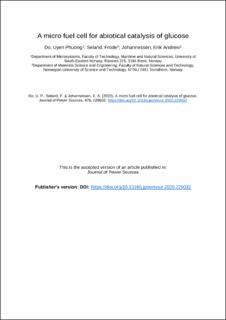| dc.contributor.author | Do, Uyen Phuong | |
| dc.contributor.author | Seland, Frode | |
| dc.contributor.author | Johannessen, Erik Andrew | |
| dc.date.accessioned | 2021-01-15T11:56:19Z | |
| dc.date.available | 2021-01-15T11:56:19Z | |
| dc.date.created | 2020-10-30T12:17:04Z | |
| dc.date.issued | 2020 | |
| dc.identifier.citation | Do, U. P., Seland, F. & Johannessen, E. A. (2020). A micro fuel cell for abiotical catalysis of glucose. Journal of Power Sources, 478, 229032. | en_US |
| dc.identifier.issn | 0378-7753 | |
| dc.identifier.uri | https://hdl.handle.net/11250/2723257 | |
| dc.description.abstract | A miniaturised abiotical fuel cell designed for operation inside a physiologically relevant mixed fuel environment of dissolved di-oxygen (DO) and glucose, have been realized by embedding the glucose sensitive anode below a porous oxygen scavenging cathode. Experimental results showed the cell capable of maintaining a power density of 2.33 ± 0.11 μW cm−2 at a current density of 7.7 μA cm−2 and a cell potential of 0.30 ± 0.01 V. This is comparable to a simulated result of 7.9 μA cm−2 in which the DO concentration from the bulk solution of 60 μM (2 ppm) were predicted to have fallen to 35 μM (1.18 ppm) before entering the cell and reacting with the anode. In contrast, the flux of glucose supplied to the anode was found to maintain a concentration of 3.7 mM inside the cell (from a bulk concentration of 5 mM). The generated power was approximately 80% of the recorded peak power density of 2.83 ± 0.24 μW, that was obtained from separating the fuels prior to use. This suggests that the proposed design were able to limit the amount of DO entering the cell prior to catalysis, and thereby minimize any reduction in the overall current density. | en_US |
| dc.language.iso | eng | en_US |
| dc.rights | Attribution-NonCommercial-NoDerivatives 4.0 Internasjonal | * |
| dc.rights.uri | http://creativecommons.org/licenses/by-nc-nd/4.0/deed.no | * |
| dc.title | A micro fuel cell for abiotical catalysis of glucose | en_US |
| dc.type | Peer reviewed | en_US |
| dc.type | Journal article | en_US |
| dc.description.version | acceptedVersion | en_US |
| dc.rights.holder | © 2020 Elsevier B.V. All rights reserved. | en_US |
| dc.source.pagenumber | 1-10 | en_US |
| dc.source.volume | 478 | en_US |
| dc.source.journal | Journal of Power Sources | en_US |
| dc.identifier.doi | https://doi.org/10.1016/j.jpowsour.2020.229032 | |
| dc.identifier.cristin | 1843583 | |
| dc.source.articlenumber | 229032 | en_US |
| cristin.ispublished | true | |
| cristin.fulltext | postprint | |
| cristin.qualitycode | 1 | |

